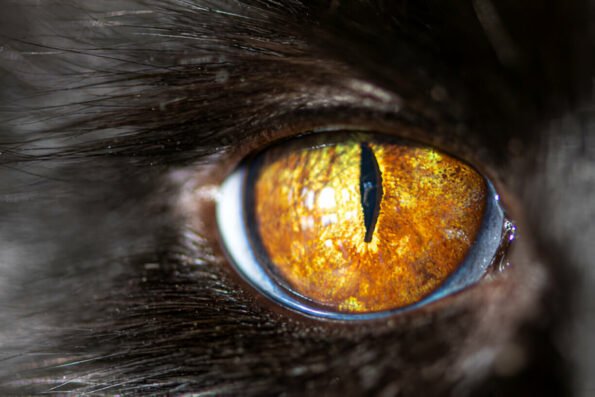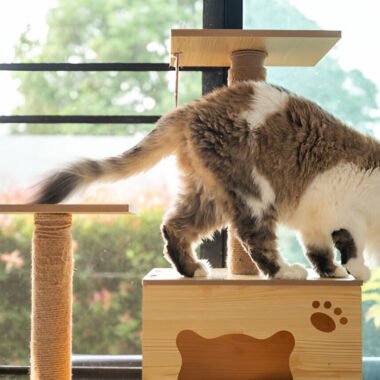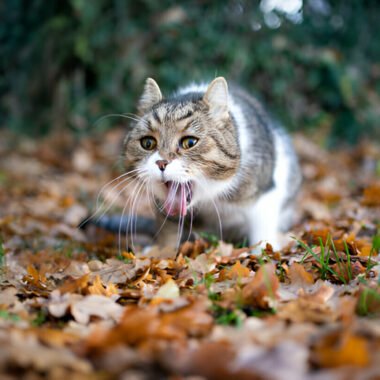Table of Contents
What Colors Can Cats See? Cats’ Secret Sight
Understanding what colors cats can see is not only fascinating but also essential for cat owners. This insight helps in creating a more engaging and stimulating environment for our feline friends. Let’s dive into the secret world of cats’ sight and uncover what colors they can actually see.
The Basics of Cat Vision
A cat’s eye is a complex and fascinating organ. Structurally, it shares some similarities with human eyes but also has unique features. Cats have a higher number of rod cells compared to cone cells. Rod cells are responsible for low light vision, while cone cells detect color. This difference significantly impacts how cats perceive the world.
Color Perception in Cats
Many people believe that cats see the world in black and white, but this isn’t entirely true. Cats do see colors, but not as vividly as humans do. Humans have three types of cone cells that allow us to see a full spectrum of colors. In contrast, cats have only two types of cone cells, which means their color vision is similar to a human who is red-green colorblind. They can see shades of blue and green, but red and pink might appear as gray or brown to them.
Scientific Studies on Cat Vision
Research on feline vision has revealed intriguing insights. Studies involving cats and color differentiation tasks show that while cats can distinguish between some colors, their perception is limited. Experiments often use colored lights and objects to determine how cats respond to different hues. These studies confirm that cats do see colors, but their world is not as vibrant as ours.
How Cats Use Their Vision in the Wild
In the wild, a cat’s vision is perfectly adapted for hunting and navigation. Their eyes are more sensitive to movement and low light conditions, making them excellent nocturnal hunters. The ability to see in low light is due to the high number of rod cells in their retinas. This adaptation allows them to detect the slightest movements of prey even in near darkness.

Cats’ Vision Compared to Other Animals
When comparing cat vision to other animals, cats have better night vision than dogs but see fewer colors. Birds, for example, have much more advanced color vision than cats. Birds can see ultraviolet light, which is completely invisible to cats and humans alike. Each species has evolved its vision to suit its environment and lifestyle.
Practical Implications for Cat Owners
Understanding cat vision can help you make better choices for your pet. When selecting toys and accessories, opt for colors that stand out in a cat’s limited color spectrum. Blue and green toys are more likely to catch your cat’s eye than red or pink ones. Designing a cat-friendly environment also involves considering their visual capabilities to make their space more engaging and stimulating.
Myths and Misconceptions About Cat Vision
There are several myths about cat vision, such as the belief that cats are completely colorblind. As we’ve discussed, cats do see some colors, just not as many as humans. Another myth is that cats can see in total darkness. While their night vision is superior to ours, they still need some light to see.
How to Test Your Cat’s Vision at Home
Testing your cat’s vision at home can be simple. You can use a variety of colored objects and observe their reactions. If your cat seems uninterested in a toy, it might be due to its color. Simple observations can give you clues about your cat’s vision. If you suspect any issues, it’s best to consult a vet.
Impact of Aging on Cat Vision
As cats age, their vision can deteriorate. Common signs of vision problems include bumping into objects, hesitating to jump, and increased vocalization, possibly due to anxiety caused by impaired sight. Regular veterinary check-ups can help detect and manage these issues early.
Caring for a Cat with Vision Problems
If your cat has vision problems, making adjustments at home can help. Keep furniture in the same place to avoid confusion, and use noise-making toys to engage their other senses. Creating a safe and predictable environment will help your visually impaired cat navigate more easily.
Cat Vision and Playtime
To stimulate your cat’s vision, choose toys in colors they can see well, like blue and green. Interactive play that mimics hunting can be especially engaging. Use movement-based toys that take advantage of their keen ability to detect motion.
Nutrition and Cat Vision
A healthy diet plays a crucial role in maintaining your cat’s vision. Nutrients like taurine, vitamin A, and omega-3 fatty acids are essential for eye health. Ensuring your cat’s diet is balanced and rich in these nutrients can help preserve their vision.
Common Eye Conditions in Cats
Be aware of common eye conditions such as conjunctivitis, cataracts, and glaucoma. Symptoms to watch for include redness, cloudiness, excessive tearing, and changes in behavior. Early detection and treatment are key to managing these conditions effectively.
Conclusion: What Colors Can Cats See?
Understanding what colors cats can see opens up a window into their world. While their color vision is limited compared to humans, it is perfectly adapted to their needs as hunters and companions. By considering their unique vision, we can enhance their environment and care for them more effectively.











